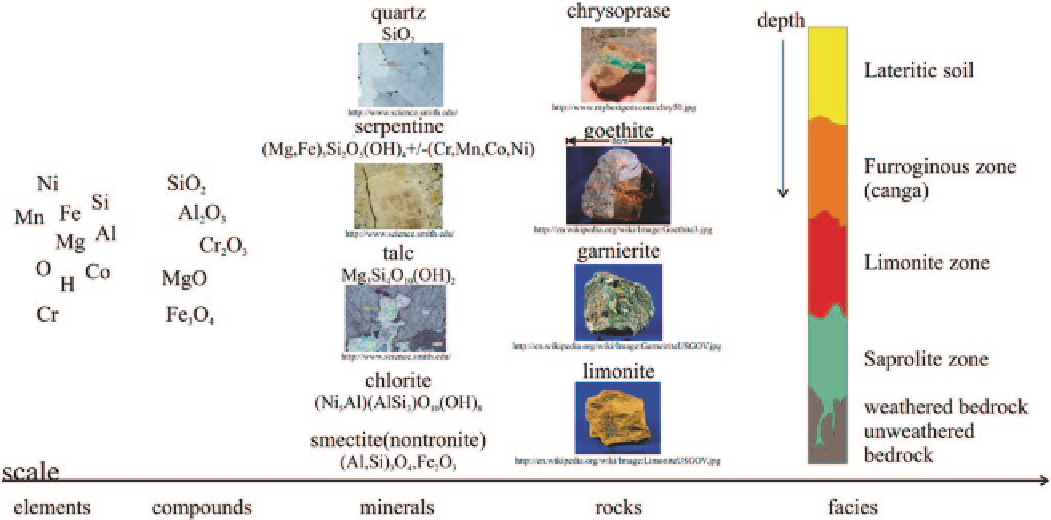Geoscience Reference
In-Depth Information
Fig. 5.11
Various scales of components of a nickel laterite deposit
and bornite. In addition, several other minerals may have
smaller amounts of Cu.
Lithological data comes in two forms: continuous like
geochemical data or categorical. The continuous component,
which can be considered on a microscopic scale, is concerned
with proportions of elements that define a particular type of
lithology, for example the percentages of sand, silt and clay
that are indicative of a sediment specimen. The macroscopic
or categorical component deals with actual lithology or fa-
cies types. Natural resources are characterized by a set of
facies types, which can be considered as compositional data
on a larger scale.
continuous. All continuous variables are measured in per-
cent and are: nickel (
Ni
), iron (
Fe
), silica (
SiO
2
), magnesium
oxide (
MgO
), cobalt (
Co
), aluminum oxide (
Al
2
O
3
) and
chromium oxide (
Cr
2
O
3
). Indicator variables are ore-type
and rock-type. Ore has been classified into seven different
types and rock into two different types.
A unit mass of material from this deposit contains some
proportion of the compounds and elements mentioned above
as well as other media, which will be denoted as
Z
. This
forms the full composition of the deposit with the other
media being a filler variable to achieve 100 % of a unit mass:
X
=
=++ + ++ + +
{ , ,
Ni Fe SiO
,
MgO Co Al O
, ,
,
Cr O
,}
Z
2
23
23
5.5.3.2 Compositional Scale
Compositional data can be defined at various scales. Geo-
chemical data for example exist at the atomic scale for spe-
cific elements, the microscopic scale for compounds of those
elements, the mesoscopic scale where different combina-
tions of compounds and elements define different minerals,
and the macroscopic scale defining facies types and lithol-
ogy zones.
An example showing the various scales is a nickel laterite
deposit. This type of deposit is typically characterized by a
very high grade of limonite clay containing 1-2 % nickel,
high iron concentrations, and trace cobalt. Other constitu-
ents are present including silica, magnesium and aluminum.
Starting with element contents, Fig.
5.11
shows the hierarchy
of clustering into compositions with increasing scale.
The nickel laterite data set consists of just over 30,000
samples with 9 variables: 2 indicator type variables and 7
100 %
Ni
Fe
SiO
MgO
Co
Al O
Cr O
Z
2
23
23
5.5.3.3 Ternary Diagrams
Due to the high dimensionality of the nickel laterite data
set, only subcompositions can be visualized. Subcomposi-
tions of size 3 plotted in a ternary diagram must undergo a
transformation to add up to 100 %. Figure
5.12
shows the ter-
nary diagrams (called also simplexes in the literature) for Ni-
Fe-SiO
2
and Ni-MgO-Co colored by ore-type. Notice that
the data are poorly distributed in the simplex. This is a com-
mon issue when one element of the composition is typically
high valued or low valued with little variability. A method
called data centering is used to redistribute data more ap-
propriately.

